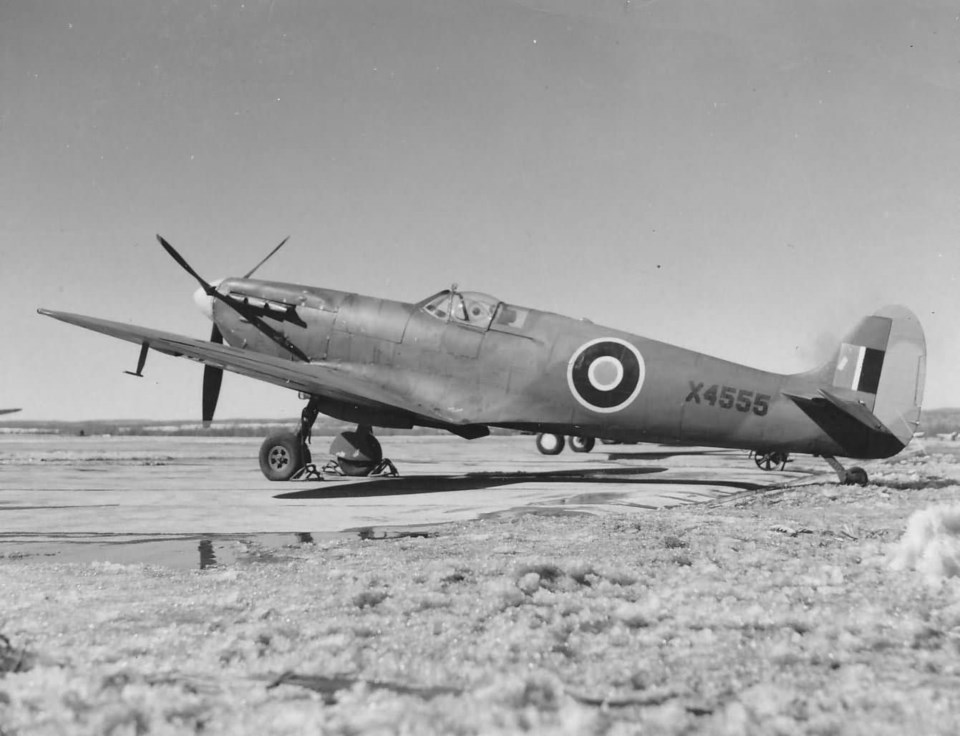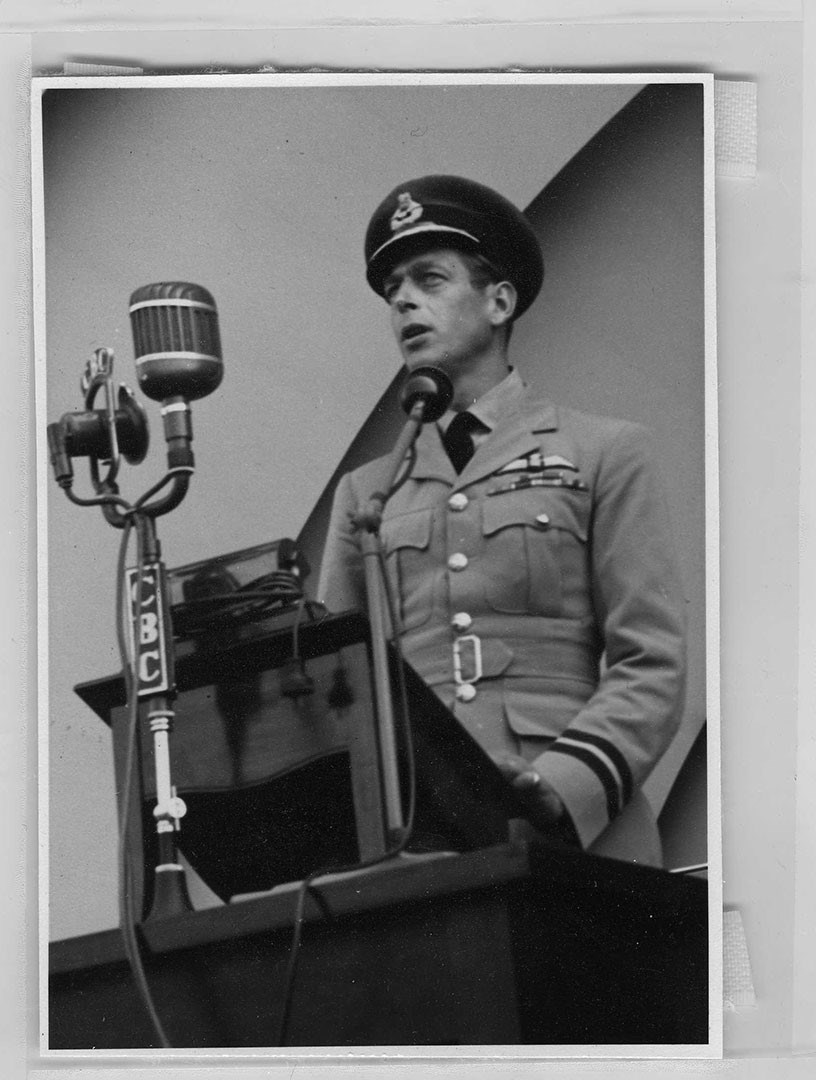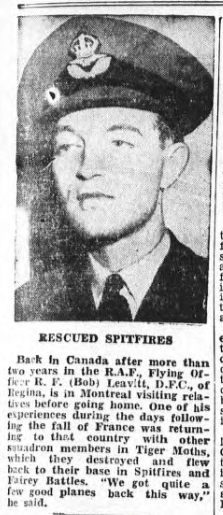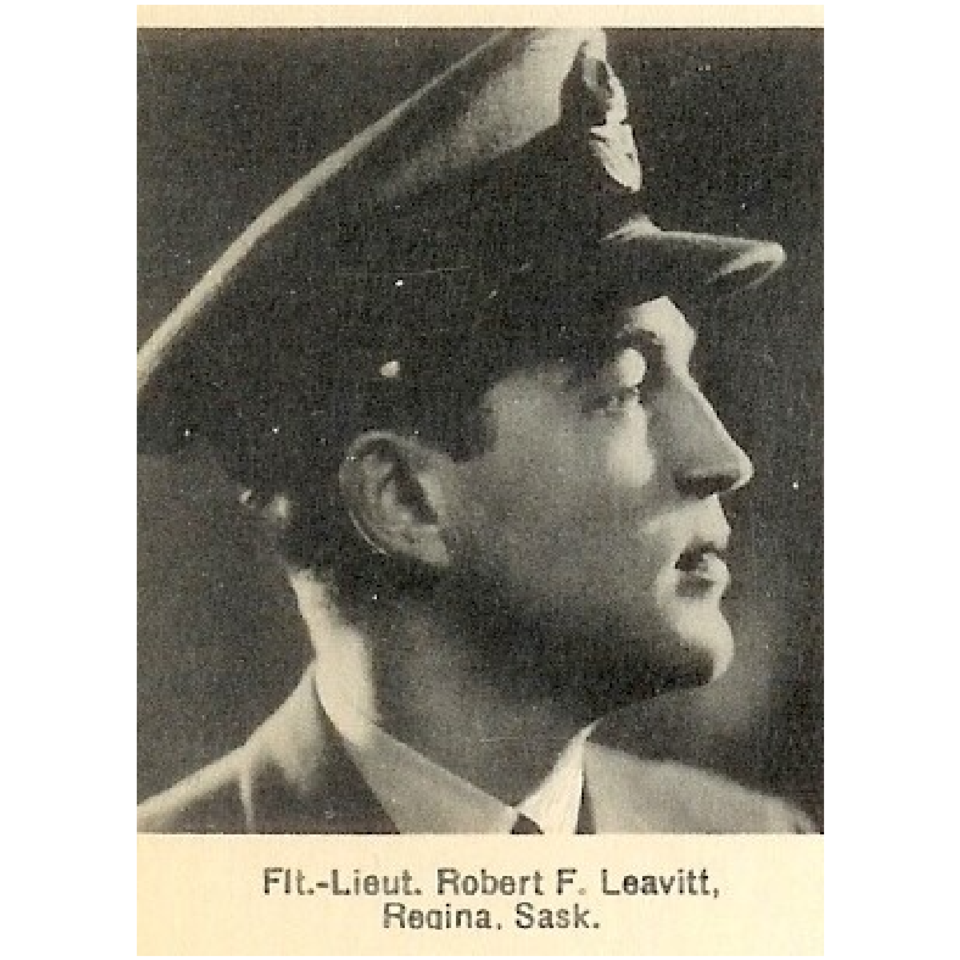Flight Lieutenant Robert Frederick Leavitt, # 42238, D.F.C., R.A.F. was born in Saskatoon on June 17, 1916 to Sherman E. and Clara B. Leavitt. Not long after, his parents moved to 2344 Broad Street, Regina, probably for the climate.
He died somewhere in the North Atlantic on September 21, 1941 while ferrying Lockheed Hudson AE545 to Prestwick, Scotland. He was 26-years of age.
Bob attended Central Collegiate, Regina and graduated in June 1934. The world was in the depths of the Great Depression. Grain prices and livestock prices had collapsed. There was little employment. Saskatchewan was in financial crisis. People left the Prairies and so did Bob.
His Dad’s brother and aunt lived in Montreal. They invited him to stay with them and ride out the Depression by attending McGill University, where he studied Chemistry.
He loved aircraft and flying. Some details are fuzzy, but it seems he got his private pilot’s licence in Montreal and applied for the RCAF. The Air Force was ‘under-funded’ because of the Great Depression and years of austerity programs. They were not taking new recruits.
It was public knowledge that the Royal Air Force was always looking for recruits for all ‘trades’. Sir Hugh Montague Trenchard, considered the father of the R.A.F., began programs to strengthen the RAF. The ‘higher-ups’ in the RAF and men like Winston Churchill, expected another war with Germany. In their opinion ‘Appeasement’ would not work. Herr Hitler would continue to take over Europe and the RAF and ‘Trenchard’s Brats’ intended to be ready for war.
Bob applied to the RAF in the fall of 1938. With a university degree and a private pilot’s licence he was a shoe-in. He was accepted and paid his own way to England in the spring of 1939 to begin RAF training. On June 10, 1939 Bob was made an Acting Pilot Officer and continued his flying training.
Rubbing Shoulders with Royalty
In early May 1940 French and British troops slowly retreated wester ward, seeking refuge at the Channel ports. On May 15, 1940 Churchill flew to Paris to view the situation and meet with French leaders. At about the same time Bob was assigned as Second Pilot on the Duke of Kent’s Hudson aircraft for one week. They became acquainted on trips to France.
Meeting Prince George, Duke of Kent led to them meeting again in Regina.
The Fall of France
When the German Army Group ‘A’ burst through the Ardennes and into France they had little trouble over-running French and British troops and pushed them west to the coast.
The French wanted more air support. British Air Chief Marshal Hugh Dowling saw it as a losing proposition. Except for the Hurricane fighters stationed in France, the British aircraft were no match for the Luftwaffe. Except for the Hurricanes, British air operational loses were as high as 75%. The Hurricane was the only aircraft of giving the Bf109 a run for its money.
Dowling had a vision of the inevitable. France would be over-run and the British would be alone on their Island. The only hope for survival as a Nation was a strong RAF Fighter Force. He would not commit any more Hurricane Squadrons to France and began pulling them back.
Fighter Command and their success in the Battle of Britain prevented a German invasion.
The fall of France was a catastrophe. The Army was evacuated at Dunkirk. The RAF Advanced Air Striking Force (AASF), used to support the Army British, were west and south of Paris, France. They needed to be withdrawn.
Between mid-May and June 20, 1940, the RAF lost almost 1000 aircraft. About 350 Hurricanes were destroyed on the ground. RAF personnel retreated to Nantes south of Paris.
Bob Leavitt played a role in flying fighters out of France. A Charlottetown PEI newspaper reported he and others flew older Tiger Moth training aircraft to RAF bases in France, torched them and flew Battles, Hurricanes or Blenheims back to Britain in June 1940. (CVWM)
Operation Aerial June 15 to 25, 1940 saw the evacuation of RAF Personnel from French ports south of Le Havre - St. Nazaire and Natnes.
Reference: Clipping from Charlottetown’s (PEI) The Guardian – ‘Returning to (France) with other squadron members in Tiger Moths, which were destroyed and flew back … Spitfires and Fairey Battles.” From CVWM
Part Two
Photo Reconnaissance Unit, Heston
Reference: The RCAF Association Awards Section – Distinguished Flying Cross Citation
After flying the Duke of Kent and before helping with the evacuation of aircraft from France, Bob was Posted to the Photo Development Unit at Heston on June 5, 1940 where he flew Blenheim and Hudson photo reconnaissance aircraft, presumably over France.
Blenheim Photo Reconnaissance Career
He first appeared in the records of the Photo Development Unit, Heston on 5 June 1940 (flying a Blenheim) and subsequently records many sorties to France and Norway on Blenheims and Hudsons.
Photo Reconnaissance Unit – Spitfire
The RCAF Records show Bob flying a Reconnaissance Spitfire to Haugesund, Norway on January 26, 1941 followed by several similar flights. The British needed to know what the Germans were up to in Norway. F/L Spencer L. Ring, 36335, D.F.C., RAF, from Regina, also spent time with the same Unit.

Bob probably flew a ‘D’ Type Photo-Reconnaissance Spitfire like this one. The armament was removed and extra fuel storage was built into the leading edge, giving the wing a “D” shape. The fuel tanks were fitted with pressure release valves in case heat built up the pressure.
This particular Spitfire was given to the RACF on April 4, 1943 where it was assigned to No. 13 Photographic Squadron. It was eventually assigned to the RCN in 1947 and no one knows what became of it after that. (Photo probably taken at Uplands, Ottawa)
Awarded the Distinguished Flying Cross
From Official Records
“Flying Officer R.F. Leavitt was detailed to take the only 'D' type Spitfire to Wick with a view to carrying out a photographic reconnaissance as far north in Norway as possible.
“On the 26th April 1941 he took off from Wick (Northern Scotland) to carry out a reconnaissance of Namsos and Trondheim. He succeeded in photographing Namsos and part of Folden Fiord, but returned over Stenkjaer and Vernes. When over the latter place anti-aircraft fire opened up and his aircraft was immediately put out of control.” (Vernes is on the Norwegian coast west of Trondheim, Norway and east of Faroe Island and Northeast of the Shetlands.)
The anti-aircraft explosion knocked Bob unconscious, fracturing his skull. He lost control of the Spitfire which dropped to 5,000. He regained consciousness and took control of the aircraft.
The jolt of the explosion had knocked the illuminous paint off the aircraft’s dials making reading them almost impossible. He was flying ‘blind’.
The explosion also damaged the engine. It would cut-out then re-start about every 30 seconds. He was able to gain altitude. Bob turned west and “… carried out a visual reconnaissance of Trondheim.” He thought of continuing on to neutral Sweden but with height he decided he could make Shetland Island, which are due west of Bergin, Norway.
He made his way south along the Norwegian coast to Stadlandet and then swung west for Shetland, all the time the engine cutting in and out.
“He succeeded in improving the running of his engine by using very low boost and engine revolutions, and decided to save the films and aircraft by returning home.” Official Records
Flying above the clouds he missed Shetland but saw Foula Island, 20 miles west of Shetland. Realizing where he was he turned south and made it back to RAF Station, Wick.
Official Record Reads: “Subsequent investigation showed that the engine had a valve and a number of ignition leads broken, while numerous starting plugs were unserviceable. This was apparently caused when the aircraft was out of control and the engine over-revved. The aircraft had its flaps damaged by the anti-aircraft fire. Its instruments were shown to be out of action.”
One assumes, once on the ground, Bob was checked himself for ‘horseshoes’.
Flying Officer Leavitt of No.1 Photographic Reconnaissance Unit received word on May 16, 1941 that he had been awarded the Distinguished Flying Cross.
His injuries meant he was sent back to Canada to recuperate with his family in Regina.
On August 14, 1941 his old acquaintance, the Duke of Kent visited the Commonwealth Air Training facilities in Regina. Flying Officer Leavitt suited up and met with the Duke at the Regina airport.

Final Flight
Bob and his two crewmen picked up Lockheed Hudson III AE545 in Montreal and were to fly it to Prestwick, Scotland. Their first stop was an overnight in Gander, Newfoundland.
Bob and the crew took off from Gander on September 21, 1941 and were never heard from again. It is assumed they lost their way, ran out of fuel and crashed into the North Atlantic without a trace.
The crew of Ferry Command Lockheed Hudson III AE545 were: Pilot, Flight Lieutenant Robert F. Leavitt, Regina; Observer/Navigator Sergeant Elwood Wallace McFall, R/54117 (RCAF) of Ottawa and civilian Radio Operator, Mr. Robert Desmond Anderson from Benjamin River, New Brunswick – all missing and presumed killed en-route from Gander, Canada to RAF Prestwick, Scotland.
Observer/Navigator Sergeant Elwood Wallace McFall had played Outside Wing for the Ottawa Rough Riders.



.png;w=120;h=80;mode=crop)

